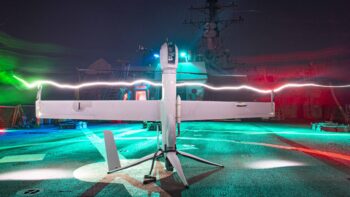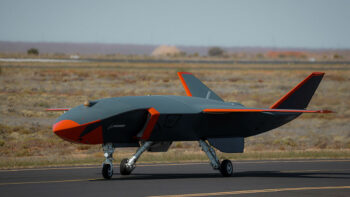
The unmanned surface vessel Ranger (left) and the HMS Dreadnought (right). (Navy photo, Navy History and Heritage Command photo)
WASHINGTON — Drone warfare in Ukraine shows that low-cost unmanned systems are already revolutionizing warfare. China is on the march in high-tech weapons and artificial intelligence. So it’s growing too late for the US and UK to make a gradual “managed transition” to the new technologies, warns a newly released report.
Instead, argue a team of experts from the London-based Royal United Services Institute (RUSI) and the Arlington, Va., Special Competitive Studies Project (SCSP), the two nations need determined military and civilian leaders to impose at least some “immediate transformational change” on the armed services from the top down.
“Realising a well-defined organisational vision can also require a certain ruthlessness,” the RUSI-SCSP report says. “It is deceptively easy to launch AI pilot programmes with impressive results, but fiendishly difficult to deliver scaled final results.”
In other words, deploying enough of the new technologies to win a major war will require diverting an ever-larger share of limited budgets from a small number of high-cost “legacy” systems — manned aircraft, surface ships and so on — to larger swarms of relatively expendable unmanned sensors, attack drones and networked AIs. That won’t happen without adroit and often sharp-elbowed politicking, the report says: “Buy-in will depend either on the cooperation of the owners of legacy assets or on their being effectively sidelined.”
The RUSI-SCSP report takes care not to explicitly criticize current policies at the US Department of Defense or the British Ministry of Defense. But it comes at a time when the Pentagon’s flagship initiative to advance low-cost unmanned weapons, Replicator, is under fire in Congress and industry for being vague and underfunded. The brainchild of Deputy Defense Secretary Kathleen Hicks, Replicator explicitly limits itself to accelerating projects submitted by the armed services, not imposing new ideas from the top down.
RELATED: Navy tests ‘tactical’ employment of unmanned ships in months-long exercise
By contrast, RUSI and SCSP invoke iron-fisted historic figures like Admiral Hyman Rickover in the Cold War, the often-tyrannical architect of the nuclear-powered navy; Defense Secretary Harold Brown in the 1970s who wielded his power over Pentagon budgets to push the armed services to adopt precision-guided weapons; and British First Sea Lord Jackie Fisher, the father of the modern “dreadnought” battleship in the years before World War I, who famously and publicly dismissed older warships as so obsolete he wanted to “scrap the lot!”

Admiral Sir John “Jackie” Fisher, 1st Sea Lord of the Admiralty (UK MOD)
Fisher’s delight in public controversy and his disdain for bureaucratic rivals, in particular, are starkly different from the cautious culture of consensus-building that dominates the Pentagon and MoD today. “The methods that Admiral Fisher used to defend and sustain change, including relatively centralised decision-making using small groups and a willingness to weather external criticism, might be at odds with contemporary managerial standards,” the report says. “This dynamic is mirrored in the careers of other successful reformers, such as Admiral Rickover.”
RUSI and SCSP are full of recommendations for would-be reformers. While they’re often couched in blandly technocratic language, they amount to a radical and politically savvy approach. The study lauds Adm. Rickover’s care to “relationships with both Congress and the press,” for instance, which he used to outmaneuver more tradition-minded admirals, and it specifically extols a highly publicized 1957 exercise when the world’s first nuclear-powered submarine, the USS Nautilus, proved able to “sink” much of the Royal Navy, convincing British politicians to fund a nuclear sub program of their own.
In the 21st century, RUSI and SCSP suggest, leaders should invoke the example of the war in Ukraine, where cheap drones and off-the-shelf software have changed the face of battle. They could also mobilize public support by directing investment to “economically flagging areas,” where companies outside the traditional specialized defense-industrial base can help build the new wave of cheaper, simpler unmanned systems.
The objective is not just tinkering on the margins but a large-scale overhaul of the armed forces.
“The UK and US militaries still must determine whether machines should be viewed primarily as cheap munitions and sources of ISR [intelligence, surveillance, and reconnaissance], or as genuine complements to inhabited platforms,” the authors write. “If militaries attempt to use machines to simply augment or replace human performance, they are likely to secure only a fraction of the possible benefits.”






















